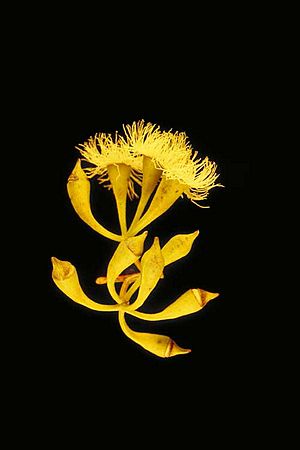Yapunyah facts for kids
Quick facts for kids Yapunyah |
|
|---|---|
 |
|
| Eucalyptus ochrophloia near Quilpie | |
| Scientific classification | |
| Genus: |
Eucalyptus
|
| Species: |
ochrophloia
|
The Yapunyah (scientific name: Eucalyptus ochrophloia) is a special type of eucalypt tree. You can find it growing naturally in the inland parts of New South Wales and Queensland in eastern Australia. It's also known as the Yapunyah tree.
Contents
What Does the Yapunyah Tree Look Like?
The Yapunyah tree usually grows to be about 15 m (49 ft) tall. Sometimes, it can even reach up to 20 m (66 ft)! This tree has a special woody swelling at its base called a lignotuber. This helps the tree regrow if it gets damaged, like from a bushfire.
The bark on the lower part of the trunk is rough and looks like a checkerboard pattern. It's usually dark grey to black. Higher up, the bark becomes smooth and can be grey, coppery, pink, yellow, or brown.
The leaves of the Yapunyah tree are glossy green and grow in an alternating pattern. They form a loose canopy, which is the leafy top part of the tree. Each leaf is shaped like a spearhead, called lanceolate. They are about 7 to 20 cm (2.8 to 7.9 in) long and 1.0 to 2.5 cm (0.39 to 0.98 in) wide. The leaf narrows down to a stalk, which is called a petiole.
Flowers and Fruits
The Yapunyah tree blooms between May and November. Its flowers grow in clusters at the ends of branches. Each cluster has seven buds. These mature buds are long and curved, about 1.0 to 1.7 cm (0.39 to 0.67 in) long and 0.4 to 0.5 cm (0.16 to 0.20 in) wide. They are green to yellow and have ribs along their sides. The top part of the bud, called the operculum, is shaped like a cone. When the flowers open, they are white.
After the flowers, the tree produces fruits. These fruits are shaped like a cylinder or a barrel. They are about 0.8 to 1.7 cm (0.31 to 0.67 in) long and 0.4 to 0.8 cm (0.16 to 0.31 in) wide. Inside the fruit, there are brown seeds. These seeds are flat and oval-shaped, about 2.0 to 2.5 mm (0.079 to 0.098 in) long.
Naming the Yapunyah
The Yapunyah tree was first officially described by a botanist named Ferdinand von Mueller in 1878. He wrote about it in his work called Fragmenta Phytographiae Australiae.
The scientific name ochrophloia comes from two Greek words. "Ochro-" means pale yellow, and "phloios" means bark. This name was chosen because the smooth bark higher up on the tree often has a pale color.
Where Does the Yapunyah Grow?
You can find the Yapunyah tree scattered across north-western New South Wales and south-western Queensland.
In New South Wales, it grows east of White Cliffs and north of the Paroo River. Here, it is often found in grassy woodlands. These trees grow along wide, flat rivers and creeks that sometimes dry up. They prefer heavy, chalky soils.
Other trees that often grow with Yapunyah in these areas include the Black Box and Coolibah trees. Smaller plants like Acacia stenophylla and Eremophila bignoniflora also grow nearby.
In drier woodland areas, the Yapunyah tree can be found with other plants like Gidgee (Acacia cambagei) and different types of Eremophila plants.
How is the Yapunyah Used?
The Yapunyah tree is very useful!
- Honey Production: Beekeepers, also known as apiarists, like this tree because it produces nectar in winter. This is a great time for bees because not many other plants are flowering then.
- Food for Birds: It's an important food source for native birds, especially the Pied Honeyeater.
- Timber: The wood from the Yapunyah tree can be used for fuel, building fences, and as strong timber for construction.
- Shade and Fodder: It provides good shade for farm animals. The leaves can also be used as food for livestock, which is called fodder.


